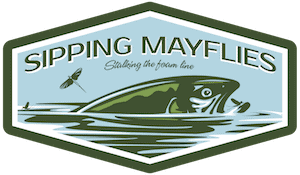Tips on Fly Fishing the BWCA
(Boundary Waters Canoe Area)
Mar. 31st, 2022
Fly fishing the BWCA (Boundary Waters Canoe Area) is an opportunity for any fly angler to hook into some giant smallmouth bass and northern pike, along with many other fish species. It’s an area unlike any other, offering world class beauty, solitude, and adventurous fishing. If you have the means, I highly recommend it.
It’s absolutely one of the best places in the world to fly fish for smallmouth bass.
I’ve been to the BWCA, and the Lake of the Woods area, several times. Having grown up in Minnesota, and having been a boy scout, it was a right of passage. There are over 2,000 lakes ranging in size from 10 acres to over 10,000 acres, and there are over 1,200 miles of rivers and streams.
After reading this article, you will have learned how to fly fish the BWCA, including what fish species exist, how to catch them, and what flies work best.
There are innumerable streams and creeks that connect many of the BWCA lakes. These streams and creeks act like highways, allowing fish to move from lake to lake. In the picture below, I’m fishing for smallies that were swimming upstream from the nearby lake.
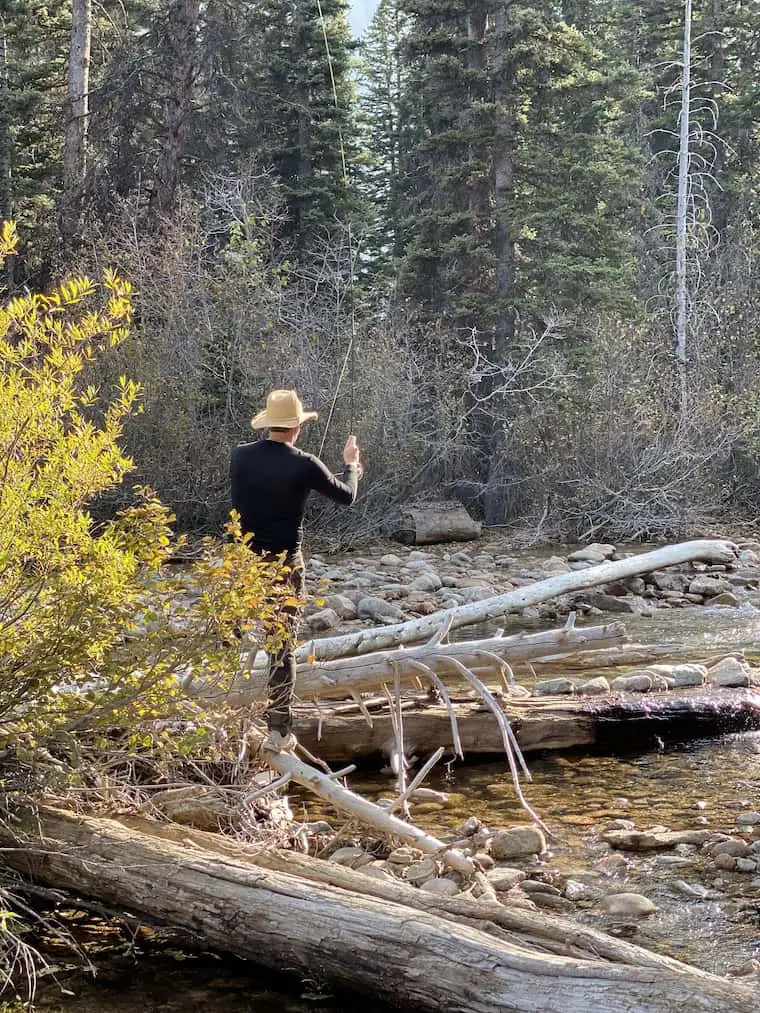
What Fish Species Live in the BWCA?
There are many species of fish that can be caught in the BWCA because there are so many lakes that comprise the area. With that said, there are a few gamefish species you’ll be chasing with your fly rod, including:
Northern pike (Esox lucius)
“Northerns” as we Minnesotans call them are ferocious predators that have earned the nickname “water wolf.” During the springtime they can be found in shallow water as they prepare to spawn. It’s during this period that they attack surface fly patterns.
You can catch them in virtually any lake. The average size you’ll catch in the BWCA is around 3-4 pounds, but 5-15 pounders are common. The BWCA record northern pike was 45 pounds and 12 ounces.
Walleye (Sander vitreus)
Walleye hold in the deeper water and using a weighted beadhead fly is your best strategy. Bounce it off the bottom. Chartreuse is the best color. The record walleye caught in the BWCA was 17 pounds and 8 ounces.
You can find walleye in Loon lake, Lac la croix, Sucker lake, Birch lake, Ottertrack lake, Saganaga lake, and Maraboeuf lake.
Smallmouth bass (Micropterus dolomieu)
Smallies are plentiful in the boundary waters. They’re terrific fighting fish, and they feed aggressively. You’ll commonly catch 3-pounders, but 5-7 pounds is not uncommon. The record catch in the BWCA was 8-pounds.
Smallmouth bass can be found in most BWCA lakes.
Black crappie (Pomoxis nigromaculatus)
Crappies aren’t common in the BWCA (no panfish are), but you’ll hook into them while fishing for smallmouth bass. You can find them in Loon lake, Lac La croix, Iron lake, Crooked lake, and many others. They’ll happily take beadhead fly patterns in black.
Largemouth bass (Micropterus salmoides)
Largemouths aren’t super common in the BWCA either. But, when you find them, they’ll take surface patterns in the evening. Your best bet is to fish Crooked lake, Sucker lake, or Birch lake.
Musky aka muskellunge (Esox masquinongy)
It’s been reported that muskies have been caught in Little Vermillion lake and the Loon river.
Lake trout (Salvelinus namaycush)
Lake trout (members of the char family) hold in deep water, usually at depths of 50+ feet. Your best bet to catch them on a fly is during the spring when they’re in the shallow water. You can find them in Look lake, Lac la croix, Carp lake, Knife lake, Saganaga lake, Maraboeuf lake, and Ottertrack lake.
A complete list of fish in the BWCA would include species you likely wouldn’t target, such as bullhead (rare), sunfish (pumpkinseed and bluegill), rock bass, burbot, whitefish, sauger, suckers (redhorse, white, longnose), sturgeon, perch, and cisco.
There are brook trout in some areas, which are planted by the Minnesota DNR (Department of Natural Resources).
This above list doesn’t include minnows.
The boundary waters area is one of the most picturesque places you’ll ever fish.
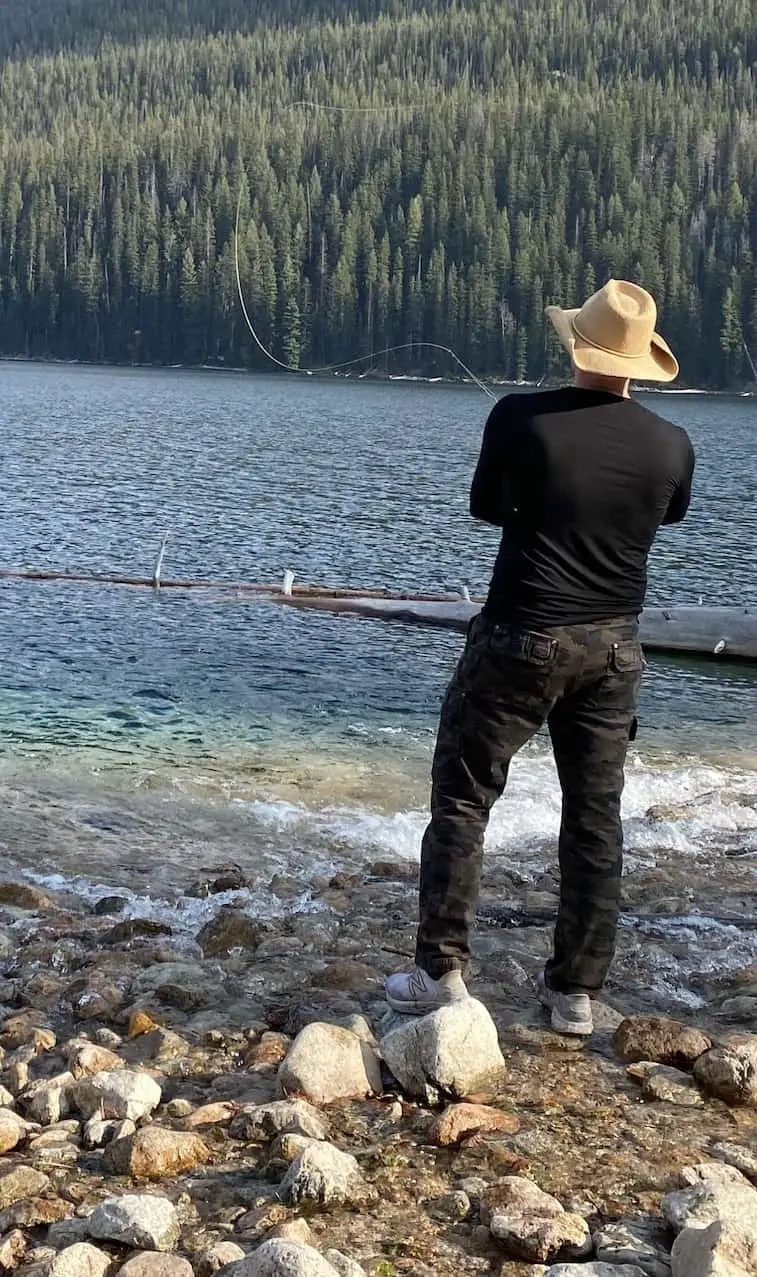
BWCA Fly Fishing Techniques
The boundary waters canoe area is full of fish, but some lakes are more productive than others. Here’s the rule that I can attest to: the farther out you get, the better the fishing will be.
In other words, the deeper you explore into the BWCA, the better the fishing. Don’t get lazy because you don’t feel like hauling your canoe through another portage. Keep going. Persist!
Fishing from a Canoe
There aren’t a lot of places to wade in the BWCA since the trees often encroach upon the shoreline. So, most of your fishing will be from a canoe and yes, it can be a challenge.
Casting from a canoe takes some getting used to. One person rows while the other person casts. It’s just how you do it, whether your fly fishing or spinfishing.
Spinfishing is a little easier from a canoe. One of the guys I was with on one trip would troll a daredevil spoon behind our canoe as we rowed across crossed each lake.
One year I did come across an old (but sturdy) dock on one of the portages we took. I stood on it and gazed into the ridiculously clear, shallow waters of the inlet. What I remember so vividly is the complete absense of panfish. I was so used to seeing sunnies around every dock in the lakes I normally fished several hours south.
The Best Fishing Seasons
I’m not going to lie, summer fishing can be more challenging. Specifically for pike. You’ll still catch northern pike on streamers, but they aren’t nearly as active, and they’re often in deeper water. July and August are the toughest.
Anglers used to believe that pike shed their teeth during the summer in the BWCA, and that’s why the fishing was so tough. That’s an old wive’s tale, but it paints a picture.
Spring is the best fishing season, athough the weather is more unpredictable. This is the only season when the northern pike, lake trout, and walleye will be in shallow water.
During the spring, you should cast streamers and surface poppers towards the shoreline. This is the time of year when giant fish in shallow water will attack your surface (and sub-surface) flies.
Fall is another good time to fish in the boundary waters, but again, the weather is a little less stable. Bring warm clothes.
General Strategies
Smallmouth bass prefer moving water. Ideally, you’ll find a stream or creek that feeds into a lake. It’s like a food conveyor belt, bringing minnows, crustaceans, and insects directly to the fish.
Here’s a spot where a waterway is emptying into a lake inlet. This is where you can find feeding smallmouth bass, as well as other species.
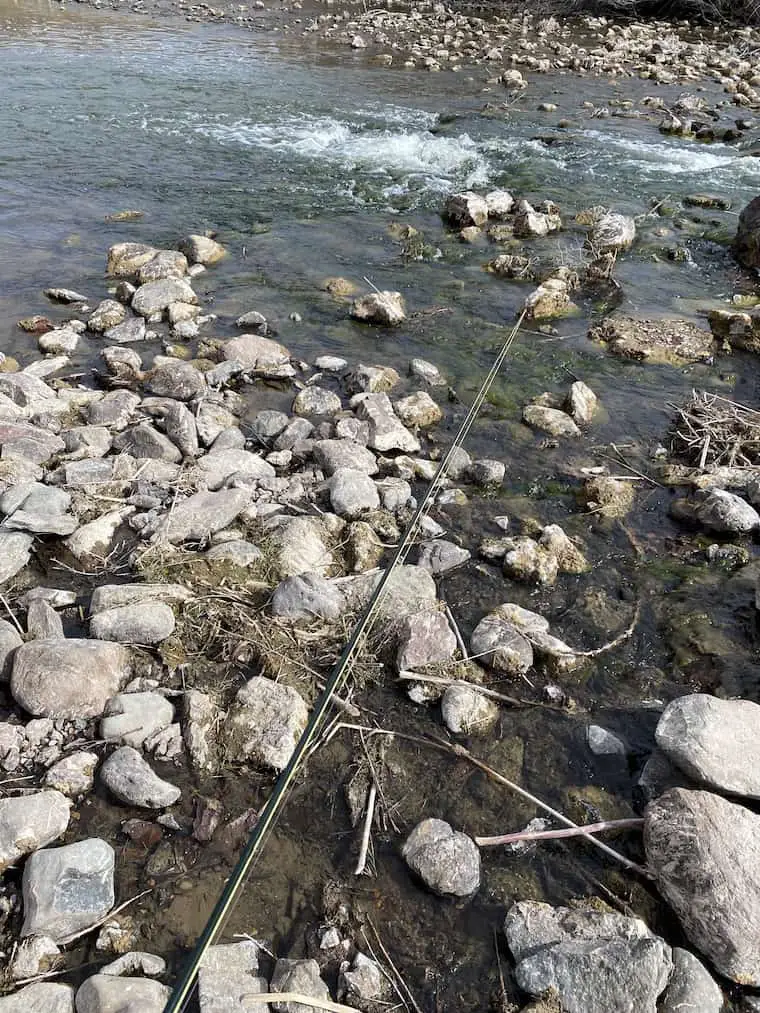
If moving water isn’t present, you’ll find smallies hanging around rock structures. Cast a weighted streamer, let it sink to the bottom, and sporadically strip it back.
Finally, stop in at an outfitter before you hit the water. Buy some flies, and then ask for advice. Ask lots of questions, but be sure you’re buying some gear. Don’t be a freeloader. In my experience, the more you buy, the better the advice will be.
The Best Boundary Waters Flies
When smallmouth bass and northern pike are taking flies on the surface, cast poppers or hoppers in size 2-6.
Streamers are going to be your go-to fly pattern in the BWCA. Specifically, patterns like the Woolly bugger in olive, black, or brown (size 6-12) will be really productive with smallmouths.
Leech and crayfish patterns can be super effective when bounced along submerged rock piles.
Clouser minnows in sizes 2-6 are terrific when you need to get a little deeper. My favorite colors are white and chartreuse.
Big streamers like the Drunk and Disorderly in sizes 2-6 will attract the attention of many large pike. Strip the fly in like it’s an injured baitfish.
Another big fly that’ll work well is a mouse pattern–the master splinter is my favorite. Fish this pattern in the evening for smallmouth and northern pike.
In reality, you don’t need to agonize over your fly patterns. Often times, the fish will hit whatever flies you throw at them. When they’re hungry, they’re not picky. This is especially true for the remote lakes.
This is something you’ll see plenty of in the boundary waters. Beavers are everywhere. Make sure you don’t ever walk on top of beaver homes, though–it can be very dangerous.
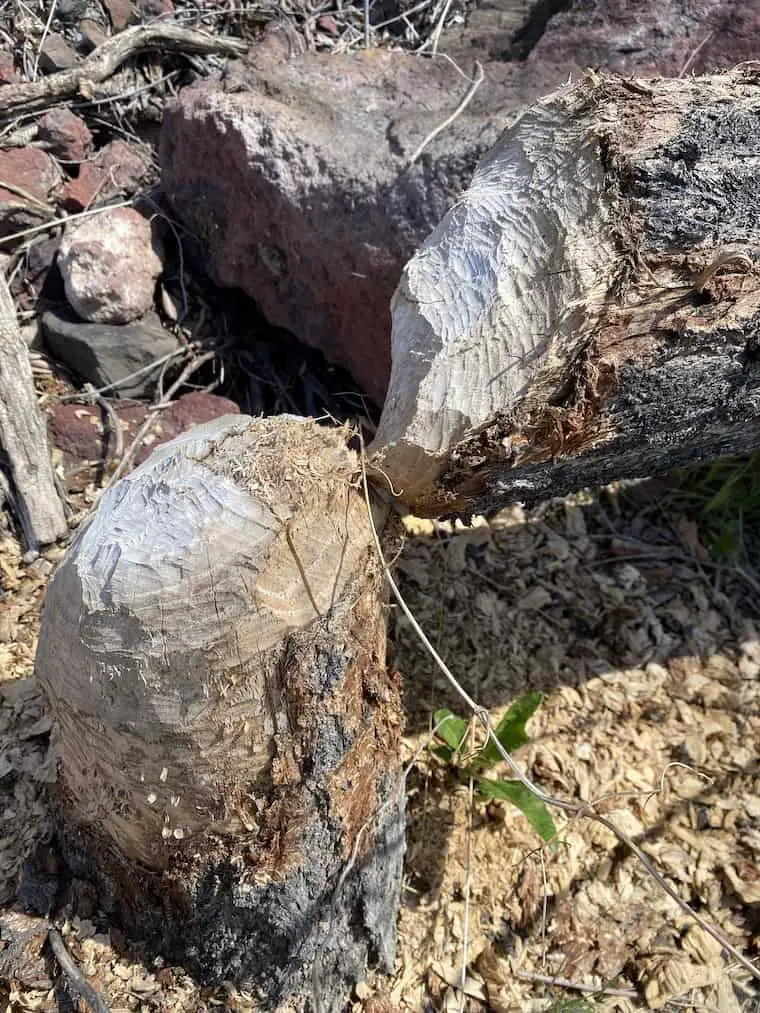
Fishing Gear for the BWCA
Bring a 7 or 8-weight fly rod. Actually, bring two if you’re smart. These rods are strong enough to bring in big pike and smallmouth.
If you had to choose, go with the 8-weight since it’ll make casting easier if the wind picks up.
You might be tempted to bring your 5-weight, but a 5-weight is too light. It’s too light to cast big streamers, it’s too light to land big fish quickly, and it’s too light to fight the wind. Don’t set yourself up for failure.
The fly line is personal preference.
If you’re going to focus on the surface, you’ll want a weight-forward floating line.
If it’s summertime and the fish are deep, consider a sink-tip or full sinking line if you’re going to focus on streamers. Nowadays, there are full sinking lines that cast nearly as well as floating line.
While not specifically fly fishing gear, you’re going to want to bring some mosquito repellent. Here’s something I learned while on a camping/fishing trip to the BWCA.
It was summer and the mosquitos were soul-crushing. They don’t come after you when you’re paddling the canoe out on the lake, but once we hit shore, it was a bloodsport.
One of the elders of the group said he’d take care of it. He took out a small spraybottle and grabbed a leaf and sprayed it. Then he walked ten feet, and sprayed another leaf, and he kept doing this until he’d made a circular perimeter around us.
I remember thinking, what good will that do, spraying it every ten feet?
Well, we couldn’t believe how well it worked. It kept mosquitos out of our camp for hours.
He said it was permethrin. I’m not sure if it’s legal nowadays, but it worked like magic.
You’ll be bolting from the water like me when the mosquitos attack.
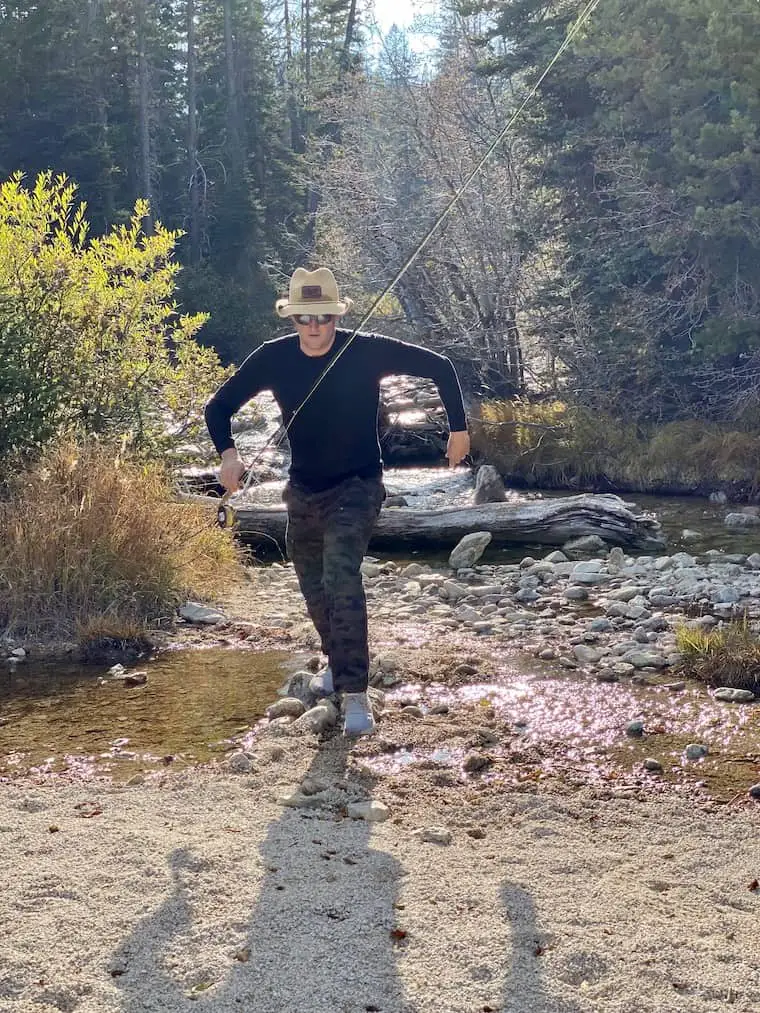
Where is the best fishing in the BWCA?
The best fishing lakes in the BWCA are, in no particular order: Iron lake, Basswood lake, Lake four, Knife lake, Birch lake, Carp lake, Newton lake, Crooked lake, Crane lake, Loon lake, and Little Vermillion. Many of the lakes are interconnected with streams and rivers, which can hold various gamefish as well.
BWCA Frequently Asked Questions
Can you fish in the BWCA?
Yes, you can fish in the BWCA. You simply need a standard Minnesota state fishing license which is available online or in-person at the Department of Natural Resources (DNR).
Are there trout in the boundary waters?
Yes, there are three species of trout in the boundary waters, including brook trout, rainbow trout, and lake trout. These farmed trout are concentrated in stocked lakes and rivers maintained by the Minnesota DNR.
Do you need a trout stamp in the BWCA?
Yes, you need a trout stamp in the BWCA if you’re going to be fishing in trout designated waters, even if you’re not targeting trout specifically. There will be signs at public access points denoting trout lakes and streams. You still need a trout stamp even if you’re using a day permit.
You do not need a trout stamp to fish in Snowbank, Burntside, Lac la croix, and Knife lakes unless you have a trout in possession or are angling specifically for trout.
A 24-hour fishing license fee automatically includes a trout stamp.
Anyone 65 years of age or older do not need a trout stamp in the BWCA.
How do you catch trout in the BWCA?
The Minnesota DNR stocks several BWCA lakes and streams with farmed trout. These areas are referred to as “put and take” stocked waters. They “put” the trout there, and you “take” them out.
Brook and rainbow trout are aggressive eaters and you won’t have any issues catching them on dry flies in lakes and streams. I’d recommend a size 20 blue winged olive (BWO). Here’s an article I wrote on BWO fly fishing tactics.
The lake trout are an entirely different story. Catching lake trout in the BWCA will require that you get very deep (50+ feet) with a weighted streamer, unless you’re fishing during the spring when they’re in shallow water.
Summary
Fly fishing in the BWCA is something every fly angler should experience at least once. Monster northern pike and smallmouth bass await you in its cold, crystal clear waters.
It’s often said that the big smallmouth bass in the BWCA will eat lemmings, if that gives you an idea of their size and aggressiveness. The nearby Lake of the Woods area is another area that could be fished in the same trip, if your schedule allows.
Whether you’re fishing a put-and-take trout lake, or a remote lake deep in the northern woods, the boundary waters canoe area is one of the world’s finest fishing destinations.
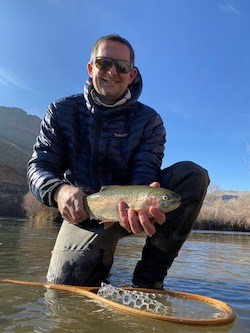
About the Author
My name's Sam and I'm a fly fishing enthusiast just like you. I get out onto the water 80+ times each year, whether it's blazing hot or snow is falling. I enjoy chasing everything from brown trout to snook, and exploring new waters is something I savor. My goal is to discover something new each time I hit the water. Along those lines, I record everything I learn in my fly fishing journal so I can share it with you.
Follow me on Instagram , YouTube, and Facebook to see pictures and videos of my catches and other fishing adventures!
